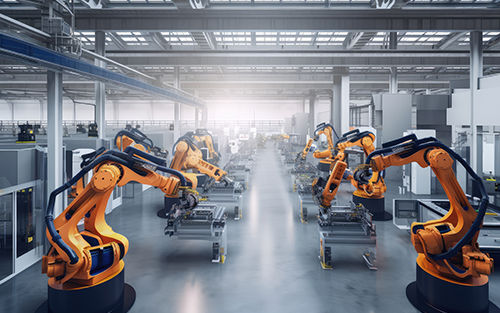summary
The manufacturing and logistics industry is changing dramatically due to the integration of AI, digital twins and cobots.

The manufacturing and logistics industry is changing dramatically due to the integration of AI, digital twins and co-robots. AI acts as an intelligent core, optimizing cobot control, predictive maintenance and supply chain management. Digital Twin provides virtual replicas to simulate and test new systems critical to optimizing human robotic collaboration and reducing deployment risk. This technical convergence increases productivity, flexibility, and safety by offloading repetitive tasks to cobots, allowing humans to focus on higher value activities. Workforce potential technologies such as AR/VR training and user-friendly interfaces ensure that human workers are not growing and remain at the heart of this evolving industrial paradigm.
The modern industrial landscape is rapidly changing, driven by the convergence of artificial intelligence (AI), digital twins and cobots. This triple not only strengthens existing operations, but also fundamentally rethinks the functions of the manufacturing and logistics sectors, creating a synergistic environment where human and machinery capabilities are maximized.
The International Federation of Robots (IFR) points out that global operating inventory of industrial robots reached 4.2 million units in 2023, with cobots taking up a significant share. Furthermore, the global Cobot sales market, worth $1020 million in 2024, is projected to reach $2,199 million by 2031, growing at a combined annual growth rate of 11.8% during the forecast period from 2025 to 2031.
At the heart of this evolution is AI, which acts as an intelligent core that coordinates many processes. Its capabilities range from optimizing cobot control and predictive maintenance to streamline strict quality control and complex supply chain management.
AI strengthens the ability of machines and robots to learn, adapt and make real-time decisions, leading to significant improvements in operational efficiency and overall responsiveness. This intelligent automation allows the industry to achieve levels of accuracy and speed that could not be achieved previously.
Digital Twin: Virtual Replica for Real Optimization
Complementing the computing power of AI is the digital twin, which provides virtual replicas of physical assets and processes. These digital models provide enterprises with invaluable sandboxes and can be rigorously tested by simulating new systems and workflows in virtual environments before committing to expensive physical implementations.
This feature is especially important for optimizing human-robot collaboration, allowing for seamless integration and fine-tuning of interactions and processes to ensure maximum power. Digital Twin’s real-time monitoring capabilities further enhance the utility, allowing for continuous optimization and proactive problem resolution. The synergy between AI and digital twins significantly reduces the risks associated with new developments and accelerates time to the market.
Empowering the human workforce: elevation and collaboration
Focusing on advanced automation may suggest a decrease in the role of human workers, but the reality is quite the opposite. Workforce enablement technology is designed to enhance and enhance human elements within this increasingly automated ecosystem. These innovative tools promote comprehensive high-skills through immersive augmented reality (AR) and virtual reality (VR) training programs, preparing the workforce for new technology and role demands.
The user-friendly interface simplifies human-robot interactions and makes it more intuitive and accessible, allowing workers to work directly with cobots. Additionally, the remote assistance feature provides on-demand professional support and ensures that human workers have the resources needed to effectively optimize operations for troubleshooting and optimizing.
Synergistic Future: Improved Productivity, Flexibility and Safety
One of the most important benefits of integrating cobots is its ability to offload repeatable, dangerous, or physically demanding tasks from human workers. This frees the human workforce and focuses on high-value activities that demand critical thinking, problem-solving and creativity.
For example, Amazon.com facilities are rapidly approaching a milestone where the number of robots is roughly equal to the number of human workers, showing strategic changes in which human ingenuity focuses on more complex challenges, while automation handles heavy lifting. This integrated approach not only promotes significant improvements in productivity, flexibility and safety, but also creates a truly synergistic relationship between cutting-edge technology and a skilled, adaptable human workforce.
The implications of this integrated approach range from various aspects of manufacturing and logistics. In manufacturing, the accuracy and speed provided by AI-powered cobots, verified through digital twin simulations, leads to reduced errors, speed of production cycles, and improved customization capabilities. This leads to high quality products and the ability to respond more quickly to market demand.
Logistics provides faster delivery times, lower operational costs and enhance inventory management through AI through supply chain optimization and efficient handling of products. The ability to simulate and optimize complex logistic networks with digital twins means that potential bottlenecks can be identified and resolved before they affect actual operations, leading to a more resilient and responsive supply chain.
Furthermore, the emphasis on enabling the workforce ensures that as technology advances, human workers become an integral part of the new industrial paradigm, rather than being left behind. The upskills initiative driven by AR/VR creates a dynamic workforce that enables continuous learning and adaptation and can navigate technological change. The simplified human robot interface removes barriers to input barriers, allowing a wider range of workers to access cooperative robotics. This human-centered approach to automation promotes a more enthusiastic and powerful workforce, leading to increased and reduced job satisfaction.
Today, the combination of AI, digital twins and cobots represents the fundamental modernization of the manufacturing and logistics landscape. AI provides intelligence, Digital Twins provide foresight, Cobots provide physical execution. This integrated approach promises a future that will be more efficient, resilient, adaptive, and ultimately lead to an unprecedented level of productivity and a more fulfilling work environment for everyone.
About the author
 Dijam Panigrahi is co-founder and COO of Gridraster Inc., a leading provider of cloud-based platforms that enhance high-quality digital twin experiences on mobile devices for enterprises.
Dijam Panigrahi is co-founder and COO of Gridraster Inc., a leading provider of cloud-based platforms that enhance high-quality digital twin experiences on mobile devices for enterprises.
Have you enjoyed this amazing article?
To read free articles, check out our free e-newsletter.
Subscribe

